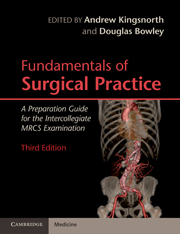Book contents
- Frontmatter
- Contents
- List of contributors
- Preface
- Section 1 Basic Sciences Relevant to Surgical Practice
- Section 2 Basic Surgical Skills
- Section 3 The Assessment and Management of the Surgical Patient
- Section 4 Perioperative Care of the Surgical Patient
- Section 5 Common Surgical Conditions
- 16 Assessment and early treatment of patients with trauma
- 17 Fundamentals of the central nervous system
- 18 Fundamentals of head and neck surgery
- 19 Fundamentals of thoracic surgery
- 20 Oesophago-gastric surgery
- 21 Fundamentals of hepatobiliary and pancreatic surgery
- 22 Fundamentals of endocrine surgery
- 23 Fundamentals of the breast
- 24 Lower gastrointestinal surgery
- 25 Fundamentals of the genitourinary system
- 26 Hernias
- 27 Fundamentals of vascular surgery
- 28 Fundamentals of orthopaedics
- 29 Fundamentals of plastic surgery
- 30 Surgical care of the paediatric patient
- 31 Fundamentals of organ transplantation
- Index
- References
16 - Assessment and early treatment of patients with trauma
Published online by Cambridge University Press: 03 May 2011
- Frontmatter
- Contents
- List of contributors
- Preface
- Section 1 Basic Sciences Relevant to Surgical Practice
- Section 2 Basic Surgical Skills
- Section 3 The Assessment and Management of the Surgical Patient
- Section 4 Perioperative Care of the Surgical Patient
- Section 5 Common Surgical Conditions
- 16 Assessment and early treatment of patients with trauma
- 17 Fundamentals of the central nervous system
- 18 Fundamentals of head and neck surgery
- 19 Fundamentals of thoracic surgery
- 20 Oesophago-gastric surgery
- 21 Fundamentals of hepatobiliary and pancreatic surgery
- 22 Fundamentals of endocrine surgery
- 23 Fundamentals of the breast
- 24 Lower gastrointestinal surgery
- 25 Fundamentals of the genitourinary system
- 26 Hernias
- 27 Fundamentals of vascular surgery
- 28 Fundamentals of orthopaedics
- 29 Fundamentals of plastic surgery
- 30 Surgical care of the paediatric patient
- 31 Fundamentals of organ transplantation
- Index
- References
Summary
Introduction
Trauma continues to be a leading cause of death and disability worldwide, and exceeds all other cause mortality combined in persons under the age of 36 years old. Globally each day 300,000 people are severely injured, with 10,000 trauma deaths. In the UK over 17,000 people die each year from accident or injury, with approximately ten times as many incapacitated or permanently disabled. The socio-economic burden to the country as a whole is difficult to quantify although estimates for trauma care in the USA are in the region of $500 billion per annum. The caveat to this is the cost of quality adjusted life years (QALYs) for injured people, which are among the cheapest in healthcare. Trauma patients are often young, fit and healthy with good potential to return to a normal life providing they receive high-quality timely intervention to enable optimal outcome from injury.
Severely injured patients have 20% higher in-hospital mortality in England and Wales (E&W) than the USA and there has been a plateau in trauma outcomes since 1994. The 2007 NCEPOD report of the management of severely injured patients reported that 52% of trauma patients receive substandard care and there may be upwards of 3000 preventable deaths in E&W annually.
- Type
- Chapter
- Information
- Fundamentals of Surgical PracticeA Preparation Guide for the Intercollegiate MRCS Examination, pp. 253 - 275Publisher: Cambridge University PressPrint publication year: 2011



